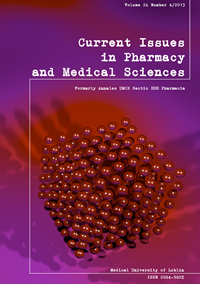Metabolic profile and morpho-functional state of the liver in rats with glutamate-induced obesity
DOI:
https://doi.org/10.12923/j.2084-980X/26.4/a.05Słowa kluczowe:
monosodium glutamate, obesity, metabolic syndrome, non-alcoholic steatohepatosis, adiponectinAbstrakt
The aim of our study was to investigate effects of monosodium glutamate (MSG) neonatal treatment on metabolic profile and liver morpho-functional state in rats at 16-weeks of age. Our study confirms previously reported data that neonatal treatment with MSG, administered by subcutaneous injection, is able to induce obesity without hyperphagia, which is diagnosed by high Lee index and characterized by small corporal weight and naso-anal length. It was established that MSG neonatal treatment induced metabolic changes at 16 weeks of age, which manifested as disproportional laying of fat deposits with the development of visceral obesity. The level of adiponectin was decreased after MSG neonatal treatment. Also, we showed development of dyslipidemia and non-alcoholic fatty liver disease and impairment sensitivity of peripheral tissue to insulin.
Bibliografia
1. Araujo P.E.: Activity increase associated with obesity induced by monosodium glutamate in mice. Amer. J. Physiol., 225, 4, 764-765, 1973.
2. Cunha N.V.: Cox-2 inhibition attenuates cardiovascular and inflammatory aspects in monosodium glutamate-induced obese rats. Life Sci., 11, 87, 375-381, 2010.
3. Dawson R.: Attenuation of leptin-mediated effects by monosodium glutamate-induced arcuate nucleus damage. Am J Physiol., 273, 1, 202–206, 1997.
4. de Souza C.T. et al: Insulin secretion in monosodium glutamate (MSG) obese rats submitted to aerobic exercise training. Physiol Chem Phys Med NMR., 35, 1, 43-53, 2003.
5. Defronzo R.A. et al: Glucose intolerance and aging: evidence for tissue insensitivity to insulin. Diabetes., 28, 12, 1095-1101, 1978.
6. Geha R. et al.: Review of alleged reactions to monosodium glutamate and outcome of a multicenter double-blind placebo-controlled study. J. Nutr., 130, 1058-1062, 2000.
7. He K. et al.: Association of monosodium glutamate intake with overweight in Chinese adults: the INTERMAP Study. Obesity., 16, 8, 1875–1880, 2008.
8. Kwok R.H.M: Chinese-restaurant syndrome. N. Engl. J. Med., 278, 20, 796, 1968.
9. Lazarin Mde O., Ishii-Iwamoto E.L., Yamamoto N.S.: Liver mitochondrial function and redox status in an experimental model of non-alcoholic fatty liver disease induced by monosodium L-glutamate in rats. Exp Mol Pathol., 91, 3, 687-694, 2011.
10. Nagata M. et al.: Type 2 diabetes mellitus in obese mouse model induced by monosodium glutamate. Exp Anim., 55, 2, 109-115, 2006.
11. Nakagawa T.: Effects of chronic administration of sibutramine on body weight, food intake and motor activity in neonatally monosodium glutamate-treated obese female rats: relationship of antiobesity effect with monoamines. Exp Anim., 49, 239–249, 2000.
12. Papa P.C. et al.: GLUT4 protein is differently modulated during development of obesity in monosodium glutamate-treated mice. Life Sci., 71, 16, 1917–1928, 2002.
13. Ribeiro Braga L.: Continuous and intermittent exercise: effects of training and detraining on body fat in obese rats. Arch Latinoam Nutr., 54, 1, 58-65, 2004.
14. Sasaki Y. et al.: Effects of bezafibrate in nonalcoholic steatohepatitis model mice with monosodium glutamate-induced metabolic syndrome. Eur J Pharmacol., 15, 662, 1-8, 2011.
15. Shi Z. et al.: Monosodium glutamate is not associated with obesity or a greater prevalence of weight gain over 5 years: findings from the Jiangsu Nutrition Study of Chinese adults - response by Shi et al. Br. J Nutr., 9, 1-7, 2010.
Pobrania
Opublikowane
Numer
Dział
Licencja
Prawa autorskie (c) 2013 Autorzy

Praca jest udostępniana na licencji Creative Commons Attribution-NonCommercial-NoDerivatives 3.0 Unported License.


